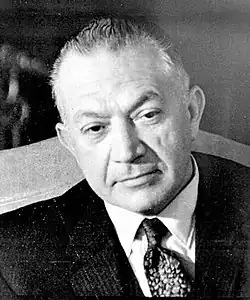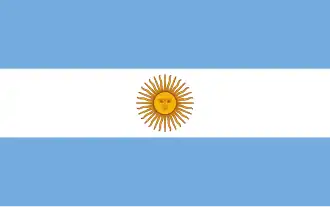Roberto Marcelo Levingston
Brigadier General Roberto Marcelo Levingston | |
|---|---|
.jpg) Levingston in 1970 | |
| 36th President of Argentina | |
| In office 18 June 1970 – 23 March 1971 | |
| Vice President | Vacant |
| Preceded by | Juan Carlos Onganía |
| Succeeded by | Alejandro Agustín Lanusse |
| Personal details | |
| Born | 10 January 1920 San Luis, Argentina |
| Died | 17 June 2015 (aged 95) Buenos Aires, Argentina |
| Political party | Independent |
| Spouse | Betty Nelly Andrés |
| Children | 3 |
| Profession | Military |
| Signature | |
| Military service | |
| Allegiance | |
| Branch/service | Argentine Army |
| Years of service | 1938–1971 |
| Rank | Brigadier general |
| Commands | Argentine Army |
| Battles/wars | Argentine Revolution |
Roberto Marcelo Levingston Laborda (10 January 1920[1][2][3] – 17 June 2015) was an Argentine Army general who was the 36th President of Argentina from 1970 to 1971.[4][5] His presidency was marked by a protectionist economic policy amid the country's financial struggles, and the imposition of the death penalty against terrorists and kidnappers.
Early life and education
Levingston was born on 10 January 1920 in San Luis Province.[6] He was the son of Guillermo David Levingston Sierralta and Carmen Laborda Guiñazú.[7][8] After completing his secondary studies, Levingston attended the Colegio Militar de la Nación starting in 1938, where he graduated from in 1941.[6] He chose to pursue the branch of cavalry officer at the college, and upon graduating became a second lieutenant of cavalry.[9] In January 1948 he obtained the rank of captain after having previously been promoted to first lieutenant.[10]
Presidency

Levingston's military expertise included intelligence and counterinsurgency, and he took the presidency of Argentina on 18 June 1970, in a military coup engineered by commander-in-chief Alejandro Lanusse that deposed Juan Carlos Onganía over his ineffective response to the Montoneros and other guerillas.[5] Lanusse later called Levingston's appointment as a "barbarity" while defending the deicision at the time, saying that "it was done so as to avoid what had been happening" under Onganía.[11]
His regime was marked by a protectionist economic policy that did little to overcome the inflation and recession that the country was undergoing at the time,[4] and by the imposition of the death penalty against terrorists and kidnappers.[5] In response to renewed anti-government rioting in Córdoba, the labor crisis under his leadership, and his attempt to dismiss Lanusse, he was deposed on 21 March 1971, by another military junta led by Lanusse.[4][5][12]
Death
He died on 17 June 2015, at the age of 95.[6] He is the longest-lived President of Argentina.[13]
Personal life
In 1943, Levingston married Betty Nelly Andrés and had two sons and one daughter.[2]
Cabinet
Levingston's cabinet underwent several changes during his brief presidency, with key ministerial positions experiencing turnover particularly in October 1970.
| Ministry | Minister | Period |
|---|---|---|
| Ministry of Interior | Eduardo Mac Loughlin
Arturo Cordón Aguirre |
18 June 1970 – 13 October 1970
15 October 1970 – 23 March 1971 |
| Ministry of Foreign Affairs and Worship | Luis María de Pablo Pardo | 18 June 1970 – 23 March 1971 |
| Ministry of Economy and Labor | Carlos Moyano Llerena | 18 June 1970 – 15 October 1970
26 October 1970 – 23 March 1971 |
| Ministry of Education | José Luis Cantini | 18 June 1970 – 23 March 1971 |
| Ministry of Social Welfare | Francisco Manrique
Amadeo Frúgoli |
18 June 1970 – 9 February 1971
10 February 1971 – 23 March 1971 |
| Ministry of Defense | José R. Cáceres Monié | 18 June 1970 – 23 March 1971 |
| Ministry of Justice | Jaime Perriaux | 18 June 1970 – 23 March 1971 |
| Ministry of Public Works and Services | Aldo Ferrer
Oscar Colombo |
18 June 1970 – 26 October 1970
26 October 1970 – 23 March 1971[14] |
References
- ^ Lentz, Harris M. (4 February 2014), Heads of States and Governments Since 1945, Routledge, ISBN 9781134264902, retrieved 13 October 2017 – via Google Books
- ^ a b The International Who's who: 1990-91, Europa Publications Limited, 13 October 1990, ISBN 9780946653584, retrieved 13 October 2017 – via Google Books
- ^ "Roberto Marcelo Levingston Laborda n. 10 Ene 1920 San Luis, San Luis, Argentina f. 17 Jun 2015 Buenos Aires, Argentina: Genealogía Familiar", Genealogiafamiliar.net, retrieved 13 October 2017
- ^ a b c Lewis, Daniel K. (2001), The History of Argentina, The Greenwood histories of the modern nations, Greenwood Publishing Group, pp. 134–135, ISBN 978-0-313-31256-4.
- ^ a b c d Keen, Benjamin; Haynes, Keith (2008), A History of Latin America (8th ed.), Cengage Learning, p. 374, ISBN 978-0-618-78318-2.
- ^ a b c "Murió Roberto Marcelo Levingston", La Nación (in Spanish), June 18, 2015
- ^ Genealogía (in Spanish). Genealogía. 1979. p. 36. Retrieved 21 June 2025.
- ^ Proceedings of the ... World Congress of Jewish Studies. World Union of Jewish Studies. 1990. p. 474. Retrieved 21 June 2025.
- ^ Hubeñak, Florencio F.; Hubeñak, Lilia A. Rodríguez de (1981). Quiénes gobiernan el mundo actual: biografías sintéticas de los dirigentes políticos de postguerra (in Spanish). Editorial Universitaria de Buenos Aires. p. 161. Retrieved 21 June 2025.
- ^ "General Complacencia ante el nombramiento de Levingston". ABC. 16 June 1970. Retrieved 21 June 2025.
- ^ "ALEJANDRO LANUSSE DIES AT 78". The Washington Post. Retrieved 2 August 2025.
- ^ "Argentine Strongman Alejandro Augustin Lanusse". The New York Times. Retrieved 2 August 2025.
- ^ Félix V. Lonigro (9 March 2019). "Cincuentones, longevos o muy jóvenes: curiosidades de las edades de los presidentes argentinos" (in Spanish). Infobae.com. Retrieved 4 July 2023.
- ^ "Boletín Oficial de la República Argentina". www.boletinoficial.gob.ar. Retrieved 2025-08-06.
